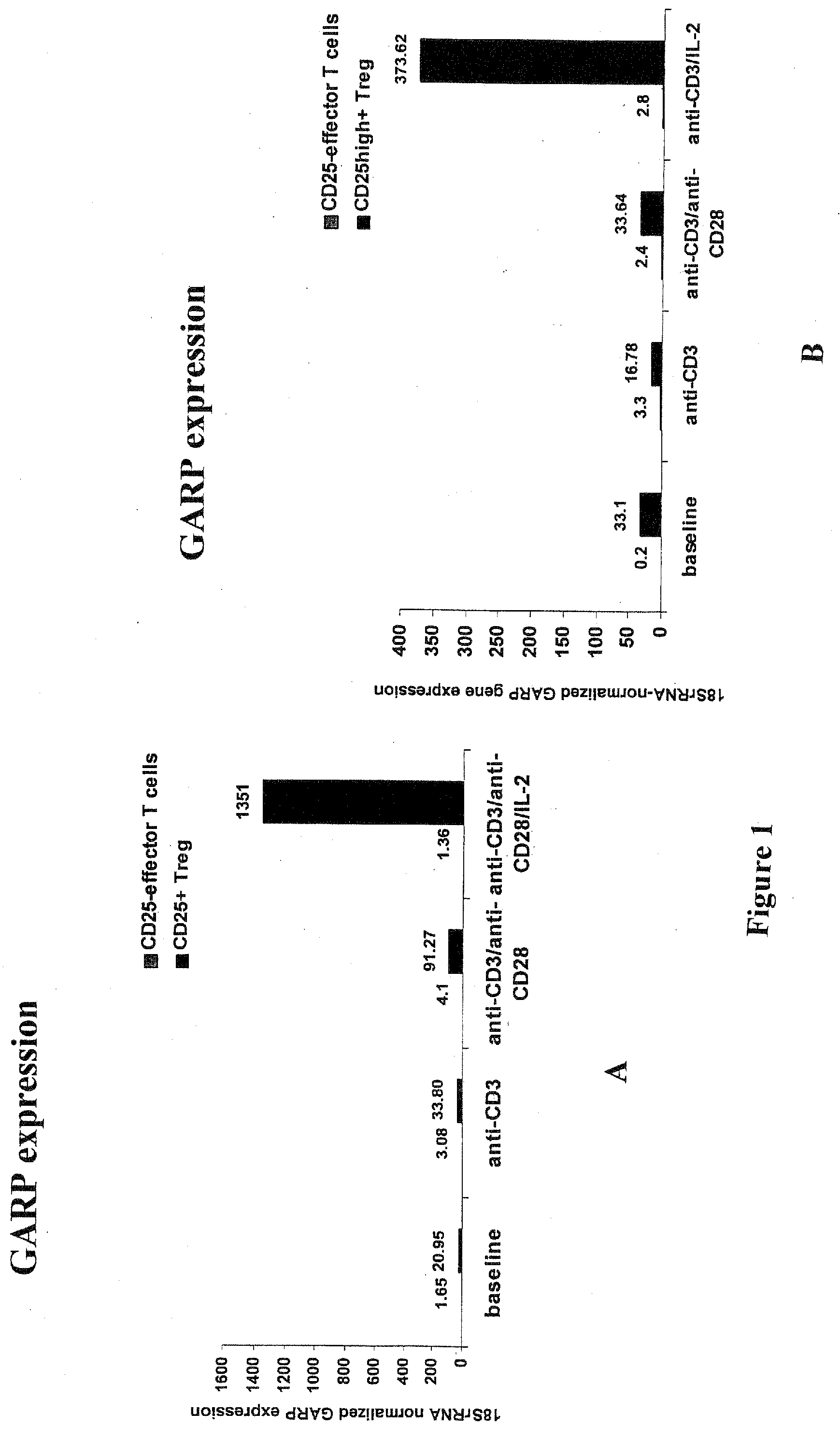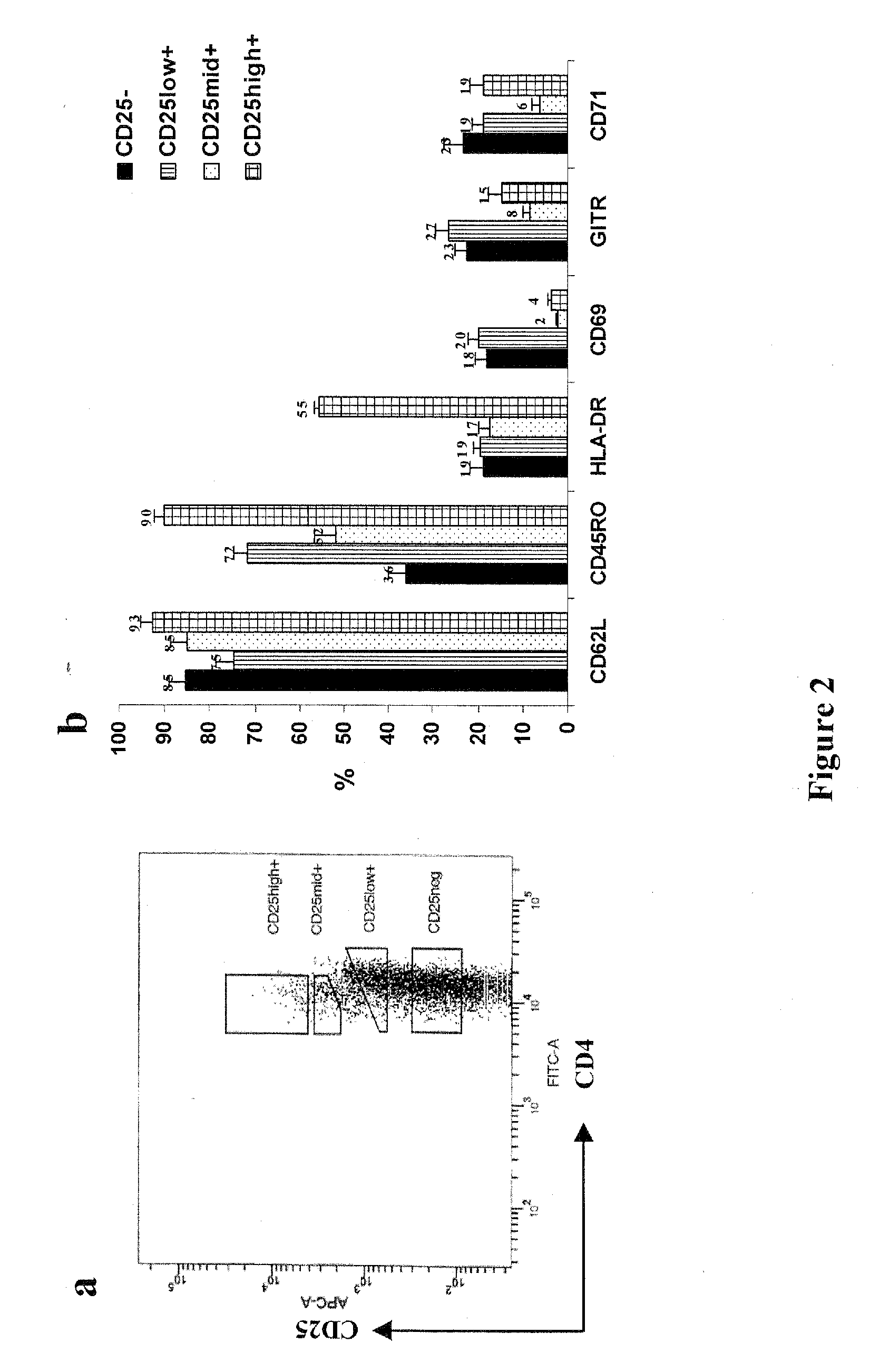Methods and Reagents for Identifying/Isolating T Regulatory (Treg) Cells and for Treating Individuals
a technology of t regulatory cells and reagents, which is applied in the field of methods and reagents for identifying/isolating t regulatory cells and treating individuals, can solve the problems of limited utility for manipulating viable cells, revealing the identity and function of human counterparts, and no further investigation of the role of suppressor t cells in psoriasis or dermatitis
- Summary
- Abstract
- Description
- Claims
- Application Information
AI Technical Summary
Problems solved by technology
Method used
Image
Examples
example 1
Identification of GARP Expression in Treg Cells
[0055]DNA microarray technology was used to compare patterns or gene expression in freshly isolated and stimulated CD25+ and CD25− cells.
[0056]To isolate cells, human peripheral blood mononuclear cells (PBMCs) were isolated from heparinized venous blood by Histopaque (Sigma-Aldrich, St. Louis, Mo.) density gradient centrifugation according to the manufacturer's directions. The cells were incubated for 30 min. with anti-CD4-FITC (BD Pharmingen, San Diego, Calif.) and anti-CD25-APC (Caltag, Burlingame, Calif.) antibodies in the culture medium (RPMI 1640 medium supplemented with 10% FBS (Cambrex Bioproducts, Walkersville, Md.), L-glutamine, penicillin, streptomycin, (all from Cellgro Mediatech Inc., Herndon, Va.) 2 Mercapto-ethanol (Sigma-Aldrich). Control PBMCs were stained with the appropriate isotype antibodies (BD Pharmingen). The cells were washed high speed flow-sorted according to their forward and side scatter properties, excluding...
example 2
Detection of GARP Expression in Unstimulated and Stimulated Treg and CD25-T Cells
[0057]Starting with PBMCs, CD4+ T cells were isolated by negative bead selection. From this CD4+ population, 3-4% of the CD4+ CD25+ population was selected and sorted. These isolated cells represent the regulatory T cell population. The cells were rested overnight. The cells (30×103 / well) were then stimulated for 72 hours with plate-bound anti-CD3 (0.5 μg / ml) in the presence or absence of soluble anti-CD28 (1 μg / ml) and / or IL-2 (50 U / ml) in 200 ul final volume of culture medium in round-bottomed 96-well plates. Seventy-two hours following stimulation, the cells were lysed and total RNA was extracted using an RNeasy mini kit (Qiagen Inc., Valencia, Calif.).
[0058]The RNA was used in real-time quantitative RT-PCR. RNA was reverse transcribed using 200U of Moloney-murine leukemia virus reverse transcriptase (MM-LV RT) (Invitrogen, Carlsbad, Calif.), according to the manufacturer's instructions. Q-RT-PCR was...
example 3
Comparison of Cell Surface Antigen Expression on CD25+ Cells
[0061]The phenotype and function of CD25high+ regulatory T cells was compared to CD25mid+, CD25low+ (1%, 2-3% and 18% of the total CD4+ population respectively) and CD25− populations. Normal human freshly isolated PBMCs were stained with anti-CD4-FITC, anti-CD25-APC or their isotype control antibodies. Positively stained CD4+ T cells were gated according to their forward and side scatter properties, excluding large activated cells. CD25high+, CD25mid+, CD25low+ and CD25− cells were high speed flow-sorted using the indicated sorting gates shown in FIG. 2A.
[0062]For phenotypic characterization of the CD25high+, CD25mid+, CD25low+ and CD25− cell subsets, the expression of various cell surface antigens on these cells was compared. Normal human PBMCs were stained with anti-CD3-PerCP, anti-CD4-APC, anti-CD25-PE, anti-CD62L-FITC, anti-CD45RO-FITC, anti-HLA-DR-FITC, anti-CD69-FITC, anti-CD71-FITC and anti-GITR-FITC or their isotype...
PUM
| Property | Measurement | Unit |
|---|---|---|
| diameter | aaaaa | aaaaa |
| volume | aaaaa | aaaaa |
| volume | aaaaa | aaaaa |
Abstract
Description
Claims
Application Information
 Login to View More
Login to View More - R&D
- Intellectual Property
- Life Sciences
- Materials
- Tech Scout
- Unparalleled Data Quality
- Higher Quality Content
- 60% Fewer Hallucinations
Browse by: Latest US Patents, China's latest patents, Technical Efficacy Thesaurus, Application Domain, Technology Topic, Popular Technical Reports.
© 2025 PatSnap. All rights reserved.Legal|Privacy policy|Modern Slavery Act Transparency Statement|Sitemap|About US| Contact US: help@patsnap.com



